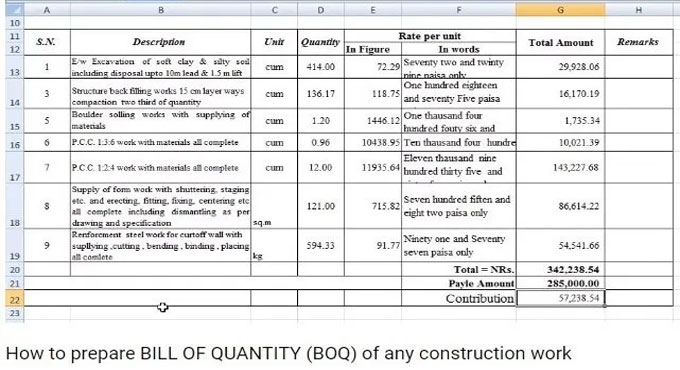NEWS | SOFTWARE | SHEET
Types of Billing of Quantities (BOQ) in Construction
Bill of Quantities even known as BOQ is actually a document created in the construction sector to designate labors, materials, as well as their cost. Furthermore, it acts as a means of communication among consultant, client as well as the contractor. Moreover, a cost consultant or a surveyor generally prepares it. Generally there’re 2sorts of BOQs.
Format for BOQ: The major parts comprised in the bill of quantities are:
- Form of Tender,
- Information,
- Requirements,
- Pricing schedule,
- Provisional sums,
- Day works.
With regard to the preparation of BOQ, five major parts are to be contemplated which are as listed below:
A. Item Description
B. Unit
C. Quantity
D. Rate for every unit
E. Overall Amount
Procedure of BOQ preparation for RCC
Taking off is the procedure of studying the drawing as well as its specifications to find the parts needed for BOQ preparation.
In that step, the suitable description of a specific work is specified to describe and explain the work being performed.
Material Calculation for Reinforced Concrete Construction:
Materials needed for reinforced concrete are steel, cement, sand and coarse aggregate. Suppose a standard quantity of 1m3 cement mortar as well as a mix proportion of 1:1.5:3 (one part cement, one point five parts sand and three parts CA). Moreover, the quantity can preferably be calculated by 2approaches, which are weight and volume method.
Assume the volume technique for reinforced concrete construction. Furthermore, dry volume of entire materials is equal to 1.54 times wet concrete volume. Therefore, assume cement mortar quantity to be 1.54 m3.
Cement quantity
The formula to determine cement volume is in the following way:
(1.54×1)/(1+1.5+3)=0.28 m3
As the cement is present in bags, one cement bag’s volume is 0.0347 m3.
0.28/0.0347= 8.07 cement bags
Sand quantity
Formula to determine sand volume is in the following way:
(1.5×1.54)/(1+1.5+3)= 0.42 m3 of sand
Coarse aggregates quantity
To determine volume of CA is in the following way:
(3×1.54)/(1+1.5+3)= 0.84 m3 of CA
Steel Reinforcement BOQ: Percentage of steel reinforcement generally relies on the sort of components utilized. Percentage values of steel vary from structure to structure. Some of which are specified below:
- Beam = 2 % concrete volume
- Slabs = 1.0% of concrete volume
- RCC roads = 0.6% concrete volume
- Column = 2.5% of concrete volume
Benefits of Billing of Quantities:
- All-inclusive project planning
- Forecast of issues and concerns
- Helpful in saving time as well as construction cost
- BOQ eradicates presumption
Bill of Quantities must be created as per a standardized method. Else, probabilities of in accuracies significantly rise. The inaccuracies that might perhaps take place in the course of the BOQ procedure are improper calculation of the quantities, errors because of several alterations done throughout the project, overlooking the variation or change in units or currencies, computational error, in appropriates up positions, as well as considering the same item two times or neglecting an item.

Image Source: engineeringcivil.org

